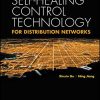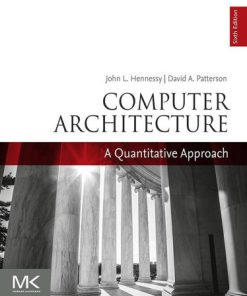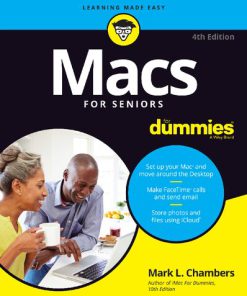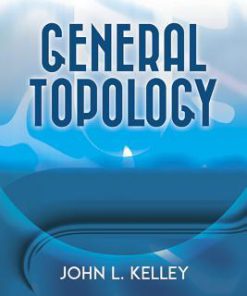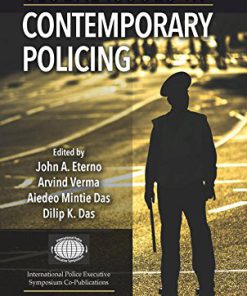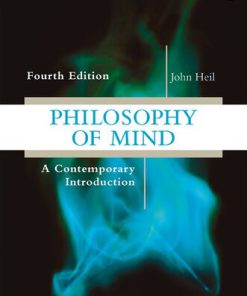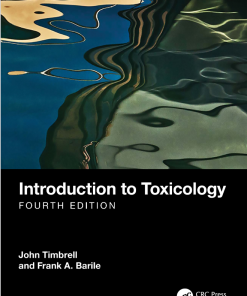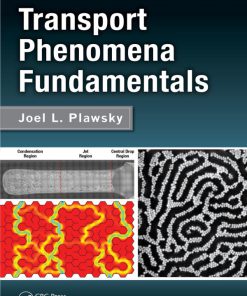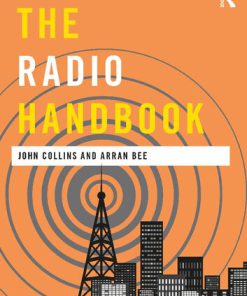Policing 4th Edition by John Worrall, Frank Schmalleger ISBN 0137926448 9780137926442
$50.00 Original price was: $50.00.$25.00Current price is: $25.00.
Policing 4th Edition by John L. Worrall, Frank Schmalleger – Ebook PDF Instant Download/Delivery: 0137926448, 978-
Full download Policing 4th Edition after payment

Product details:
ISBN 10: 0137926448
ISBN 13: 978-0137926442
Author: John L. Worrall, Frank Schmalleger
Policing is a clear, thought-provoking exploration of core concepts, the latest research and current events shaping criminal justice today. As part of the Justice Series, it’s built to be affordable without sacrificing academic rigor, and it will move you beyond memorization to true understanding. The concise, conversational writing style keeps the content engaging while supporting your comprehension.
The 4th Edition has been extensively revised with the latest research and court cases. Changes appear throughout, including coverage of procedural justice, defunding the police and de-escalation. Updated case studies at the start and end of each chapter highlight the latest issues confronting US police forces.
Policing 4th Table of contents:
Part 1: Foundations
Chapter 1: Origins and Evolution of American Policing
- Learning Objectives
- Introduction
- Policing Immigrant Populations
- The Origins of Policing
- From Private to Public Policing
- The Influence of the English Model
- Policing Comes to America
- Chaos in the Cities
- The Move West
- Policing the Slaves
- Policing Eras
- The Political Era
- The Reform Era
- The Community Era
- O. W. Wilson and the Limitations of Professionalism
- Toward Customer Service
- New Policing Eras?
- Beyond Local Law Enforcement
- The Emergence of State Agencies
- The First Federal Agencies
- US Marshals
- Postal Inspectors and Secret Service
- The FBI
- Chapter 1 Review: Origins and Evolution of American Policing
- Endnotes
Chapter 2: Policing in the American Context
- Learning Objectives
- Introduction
- A Turnaround in Policing
- Policing in American Government
- Policing in a Democracy
- Consequences of Democracy for Police
- Policing and Federalism
- Consequences of Federalism for Policing
- The Police Organizational Environment
- The Community
- Race and Support
- Age and Support
- Men versus Women
- Prior Contact
- Other Factors Affecting Public Perceptions
- Sheriffs and the Electorate
- Government Officials
- Executive Influence
- City Councils
- Mayors
- Police Commissions
- Other Appointing Authorities
- Legislative Influence
- Judicial Influence
- The Media
- Media Portrayals of the Police
- Impression Management
- The Public Information Officer: An Asset?
- Other Law Enforcement Agencies
- Professional Associations
- Police as a Piece of the Criminal Justice Puzzle
- The Criminal Justice Process
- Relationships with Prosecutors
- Relationships with Corrections Officials
- Chapter 2 Review: Policing in the American Context
- Endnotes
Chapter 3: Law Enforcement Agencies and Their Organization
- Learning Objectives
- Introduction
- The 30×30 Pledge
- Agencies of Law Enforcement
- How Many Are There?
- Federal Agencies
- Homeland Security Agencies
- Secret Service
- Customs and Border Protection
- Immigration and Customs Enforcement
- Justice Department Agencies
- FBI
- US Marshals Service
- Bureau of Alcohol, Tobacco, Firearms, and Explosives
- Drug Enforcement Administration
- State Agencies
- The Centralized Model
- The Decentralized Model
- Local Agencies
- Municipal Police
- Sheriff’s Departments
- The Organization of Law Enforcement Agencies
- How Police Departments Differ from Other Organizations
- Staff versus Line Duties
- Chain of Command
- Traditional and Contemporary Organization
- Classical Organizational Theory
- Contemporary Organizational Theory
- Private Policing and Security
- Private Security versus Private Policing
- Private Policing Methods
- Controversies in Private Policing
- Chapter 3 Review: Law Enforcement Agencies and Their Organization
- Endnotes
Part 2: A Career in Policing
Chapter 4: Becoming a Cop
- Learning Objectives
- Introduction
- Reshaping Policing
- Hiring and Training
- The Hiring Decision
- Recruitment
- Testing Requirements
- The Interview
- Background Investigations
- Polygraph Exam
- Medical and Drug Screening
- The Academy and Field Training
- Types of Academies
- Curricular Issues
- Learning the Sixth Sense
- The Academy Experience
- Field Training and Development
- Diversity and Discrimination
- Equal Employment Opportunity
- Affirmative Action
- Minorities in Policing
- Women in Policing
- Disabled Officers
- Realities of the Job
- Stress
- Nature and Symptoms of Stress
- Gendered Nature of Police Stress
- Burnout
- Critical Incidents
- Fatigue
- Scheduling and Workload
- Sexual Harassment
- Chapter 4 Review: Becoming a Cop
- Endnotes
Chapter 5: Police Subculture
- Learning Objectives
- Introduction
- Danger and Unpredictability in Police Work
- Culture: What Is It?
- Culture versus Subculture
- Elements of Culture
- Various Themes
- Institutional Values
- Emotional Expression
- Sources of Police Subculture
- Organizational Factors
- The Street Environment
- Administration
- Other Criminal Justice Agencies
- The Media
- Components of Police Subculture
- Control of Territory
- Use of Force
- Danger, Unpredictability, and Suspicion
- Solidarity
- Moral Superiority
- Common Sense
- The Masculine Environment
- Secrecy
- Chapter 5 Review: Police Subculture
- Endnotes
Chapter 6: Police Discretion and Behavior
- Learning Objectives
- Introduction
- Defining Discretion
- Classic Studies of Police Discretion
- Violence and the Police
- Managing Appearances
- Policing Styles
- Working the Street
- The Pros and Cons of Police Discretion
- Discretion and Seniority
- Explaining Police Behavior
- Universalistic and Particularistic Perspectives
- Police Decision Making
- Organizational and Situational Factors
- Individual Officer Characteristics
- Implicit Bias
- Chapter 6 Review: Police Discretion and Behavior
- Endnotes
Part 3: On the Job
Chapter 7: Core Police Functions
- Learning Objectives
- Introduction
- The Police Mission
- Patrol
- Types of Patrol
- Patrol Methods and Techniques
- Effectiveness of Patrol
- The Response Role
- Routine Incident Response
- Emergency Response
- The Traffic Function
- Pretext Stops and Profiling
- Accident Investigation
- Pursuits
- Peacekeeping and Order Maintenance
- Managing Disorder
- The Broken Windows Model
- Civil Disobedience
- Investigations
- Evolution of Investigations
- Investigative Goals and Process
- Undercover Work
- Problems with Undercover Work
- Chapter 7 Review: Core Police Functions
- Endnotes
Chapter 8: Community Policing and Community Involvement
- Learning Objectives
- Introduction
- Community Justice and Problem-Oriented Policing
- Community Policing
- The Birth of Community Policing
- Crime Control and Other Intentions
- Examples of Community Policing
- The Future of Community Policing
- Citizen Involvement and Civilianization
- Citizen Patrol and Police Academies
- Third-Party Policing
- Beyond the Criminal Law
- Chapter 8 Review: Community Policing and Community Involvement
- Endnotes
Chapter 9: Policing in the Modern Era
- Learning Objectives
- Introduction
- Policing and Emerging Technology
- Advances in Crime Mapping and Predictive Analytics
- Geographic Profiling
- Smart Sensors and Virtual Patrols
- Intelligence-Led Policing
- Evidence-Based Policing
- Chapter 9 Review: Policing in the Modern Era
- Endnotes
Part 4: Legal Issues
Chapter 10: Policing and the Law
- Learning Objectives
- Introduction
- Search and Seizure
- What Is a Search or Seizure?
- Justification: Probable Cause and Reasonable Suspicion
- Rules of Search and Seizure
- Warrant Requirements
- Searches Without Warrants
- Stop-and-Frisk and Special-Needs Searches
- Confessions and Interrogations
- The Miranda Approach
- Controversy over Miranda
- Public Safety Exception
- Chapter 10 Review: Policing and the Law
- Endnotes
Chapter 11: Civil Liability and Accountability
- Learning Objectives
- Introduction
- Civil Liability
- Section 1983 Liability and Theories of Liability
- State Tort Liability
- Defenses
- External Accountability Measures
- Citizen Oversight
- Citizen Complaints and Consent Decrees
- Agency Accreditation
- Criminal Prosecution
- Internal Accountability
- Internal Affairs
- Codes of Ethics
- Sentinel Event Reviews
- Chapter 11 Review: Civil Liability and Accountability
- Endnotes
Part 5: Challenges
Chapter 12: Deviance, Ethics, and Professionalism
- Learning Objectives
- Introduction
- Discovering Deviance
- Police Crime, Occupational Deviance, and Corruption
- Abuse of Authority
- Other Forms of Deviance
- Explanations, Incidence, and Controls
- Controlling Deviance
- Professional Standards and Codes of Ethics
- Consent Decrees
- Chapter 12 Review: Deviance, Ethics, and Professionalism
- Endnotes
Chapter 13: The Use of Force
- Learning Objectives
- Introduction
- Deadly Force
- Legal Standards for Use of Force
- Federal Policy on Deadly Force
- Nondeadly Force and Less Lethal Weapons
- Excessive Force and Abuse of Authority
- Chapter 13 Review: The Use of Force
People also search for Policing 4th:
community policing
diploma in policing
tone policing
problem oriented policing
moral policing meaning
Tags:
John Worrall,Frank Schmalleger,Policing 4th
You may also like…
Computers - Hardware
Computers - Hardware
Mathematics
Uncategorized
Global issues in contemporary policing 1st Edition by John Eterno 1315436951 9781315436951
Politics & Philosophy - Anthropology
Medicine - Clinical Medicine
Engineering - Chemical Engineering
Transport Phenomena Fundamentals 4th Edition Joel L. Plawsky
Computers - Programming
Engineering



